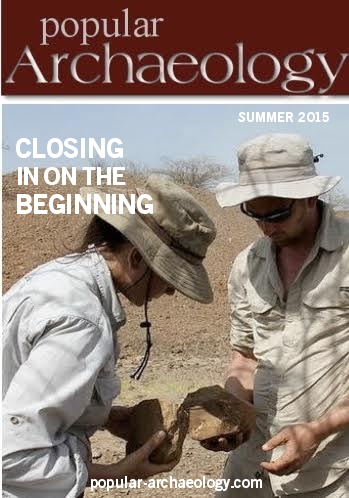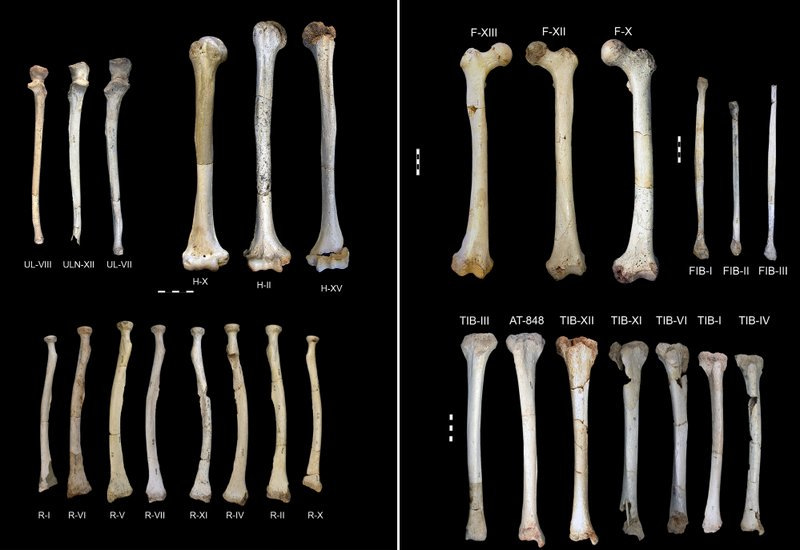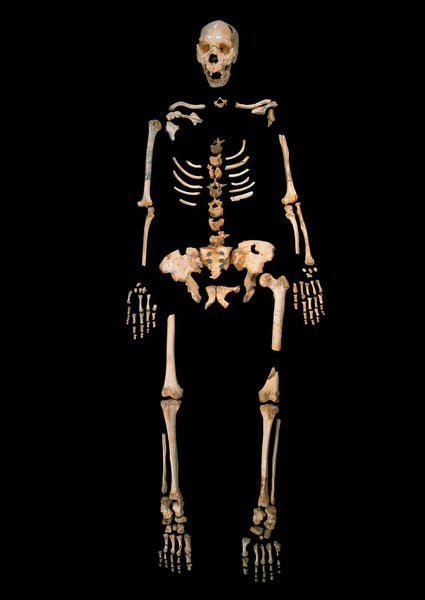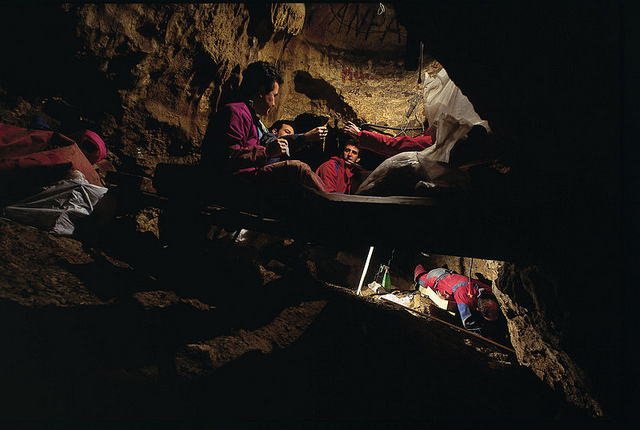
After examining the body size and shape of fossils from the Sima de los Huesos (SH) site in Spain, researchers report evidence that Neanderthal features did not arise in tandem as a package but instead followed a mosaic pattern of evolution, wherein evolutionary changes in some body parts preceded others. SH is a Middle Pleistocene site with the largest collection of postcranial skeletons—parts of the skeleton apart from the skull—ever found. The skeletal remains, including the cranial (skull) specimens, represent individuals of a single population of early humans who lived about 430,000 years ago in what is presently northern Spain.
Juan Luis Arsuaga of the Centro Mixto Universidad Complutense de Madrid and colleagues closely examined and measured 1,523 fossil elements, representing a minimum number of 19 individuals, from the collection using raw values for key skeletal parts as proxies to estimate stature, body breadth, and weight. They also compared the results for the same values from data derived from other early human fossils, including hominins dated to much earlier times. From these results, they were able to characterize the body design of SH postcranial skeletons, finding that the SH individuals were relatively tall, with wide, muscular bodies. Although similarly built to Neanderthals, they had generally less brain mass than the classic Neanderthals. They were shorter, wider and more robust than the much later Homo sapiens, or modern humans (MH), with less brain to body mass. The researchers concluded that the SH humans shared many anatomical features with Neanderthals, although some other key Neanderthal features were not present in the SH group of fossils, suggesting in their analysis that the SH humans were a sister group to later Neanderthals, and that the characteristics that eventually defined later Neanderthals did not all evolve together, but separately, in a mosaic pattern through time. They also concluded that the generally wide SH body plan provided additional evidence that early humans, before Homo sapiens, changed relatively little in this respect over the million years preceding the rise of modern humans. Modern humans, compared to their more ancient SH, Neanderthal, and other ancestral species and cousin lineages, are generally taller, narrower, and with the largest brain mass to body mass relationship (more encephalized).
________________________________________________
This image shows the upper and lower limb bones of those adults found in Sima de los Huesos, Atapuerca, Spain. Image: Carretero et al.
________________________________________________
This is a complete SH skeleton assembled from samples excavated at Sima de los Huesos. Javier Trueba, Madrid Scientific Films
_______________________________________________________________
A team at work inside the cave: The Sima de los Huesos site. Image courtesy Javier Trueba / Madrid Scientific Films
________________________________________________
“In sum,” concluded the researchers, “SH offers the best proxy for the general postcranial size and shape of Homo for at least the past 1 million years until the appearance of MH. Despite large periods of morphological stasis in the general body plan, the anatomical details of the postcranial skeleton, as revealed in the SH sample, offer the best evidence for a pattern of mosaic evolution in the postcranium within the Neandertal lineage.”*
The paper is published in the Proceedings of the National Academy of Sciences.
________________________________________________________________
*Juan-Luis Arsuaga et al., Postcranial morphology of the middle Pleistocene humans from Sima de los Huesos, Proceedings of the National Academy of Sciences, www.pnas.org/cgi/doi/10.1073/pnas.1514828112
________________________________________________________________
 Read more in-depth articles about archaeology with a premium subscription to Popular Archaeology Magazine.
Read more in-depth articles about archaeology with a premium subscription to Popular Archaeology Magazine.
In addition, the latest Popular Archaeology ebook is now available.
______________________________________________
Travel and learn with Far Horizons.
____________________________________________
 This richly illustrated ebook version of a recent Popular Archaeology issue includes the following stories: The discovery of the tomb of a previously unknown pharaoh that is shedding light on a lost ancient Egyptian dynasty; how genetics is revolutionizing what we know about human evolution and our prehistoric past; one scholar’s controversial ‘New Chronology’ and how it supports the historicity of the biblical Exodus; how archaeologists are unearthing new history in Williamsburg, Virginia, a seat of British colonial power in 18th century America; the discovery of the remains of a major Roman legionary base in Israel; the unearthing of an ancient Judean fortified settlement in the borderlands between the biblical kingdoms of ancient Judah and the Philistines; and how archaeologists are uncovering evidence of what may have been an important administrative center of Judah during the 8th century BCE. Now available from Amazon.com!
This richly illustrated ebook version of a recent Popular Archaeology issue includes the following stories: The discovery of the tomb of a previously unknown pharaoh that is shedding light on a lost ancient Egyptian dynasty; how genetics is revolutionizing what we know about human evolution and our prehistoric past; one scholar’s controversial ‘New Chronology’ and how it supports the historicity of the biblical Exodus; how archaeologists are unearthing new history in Williamsburg, Virginia, a seat of British colonial power in 18th century America; the discovery of the remains of a major Roman legionary base in Israel; the unearthing of an ancient Judean fortified settlement in the borderlands between the biblical kingdoms of ancient Judah and the Philistines; and how archaeologists are uncovering evidence of what may have been an important administrative center of Judah during the 8th century BCE. Now available from Amazon.com!
____________________________________________








